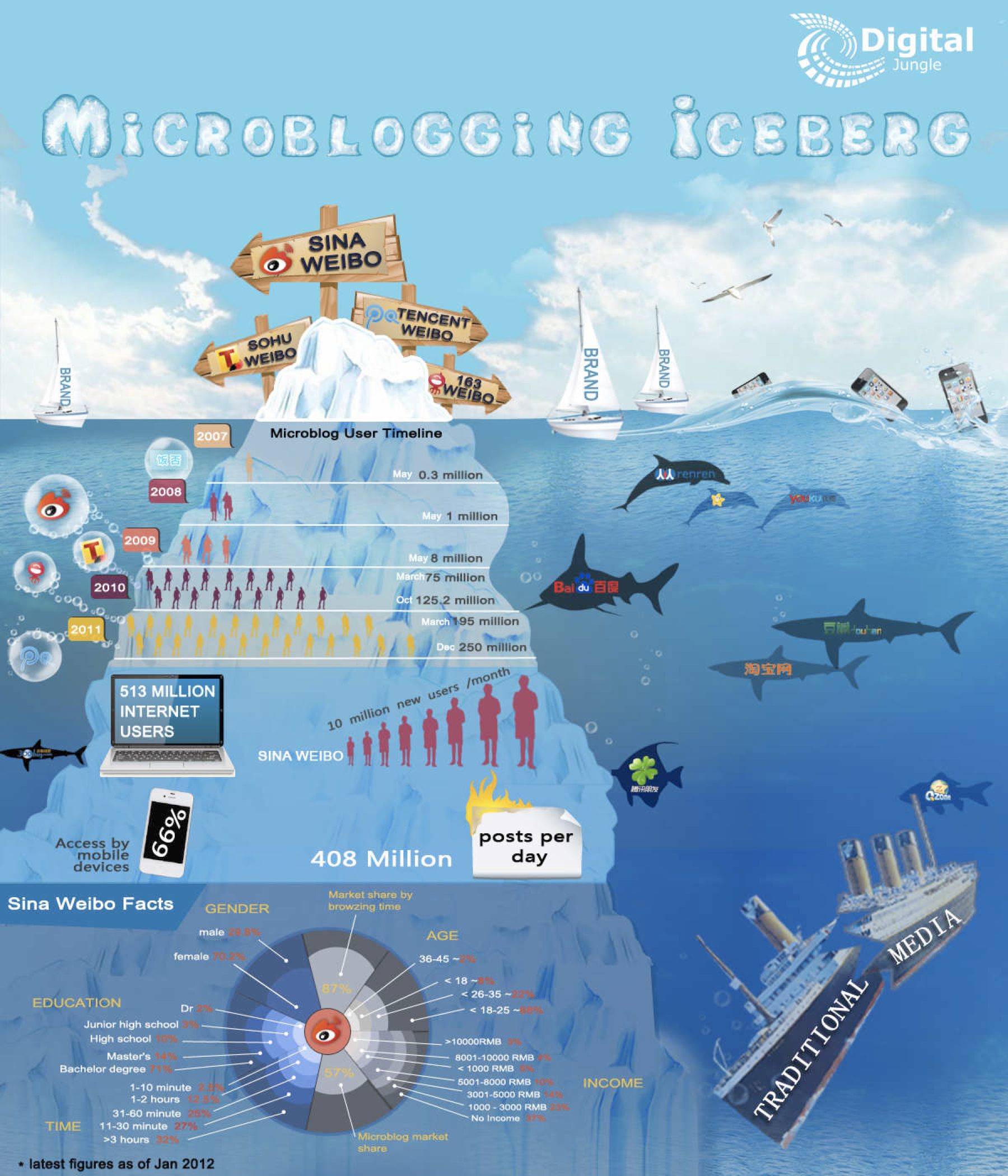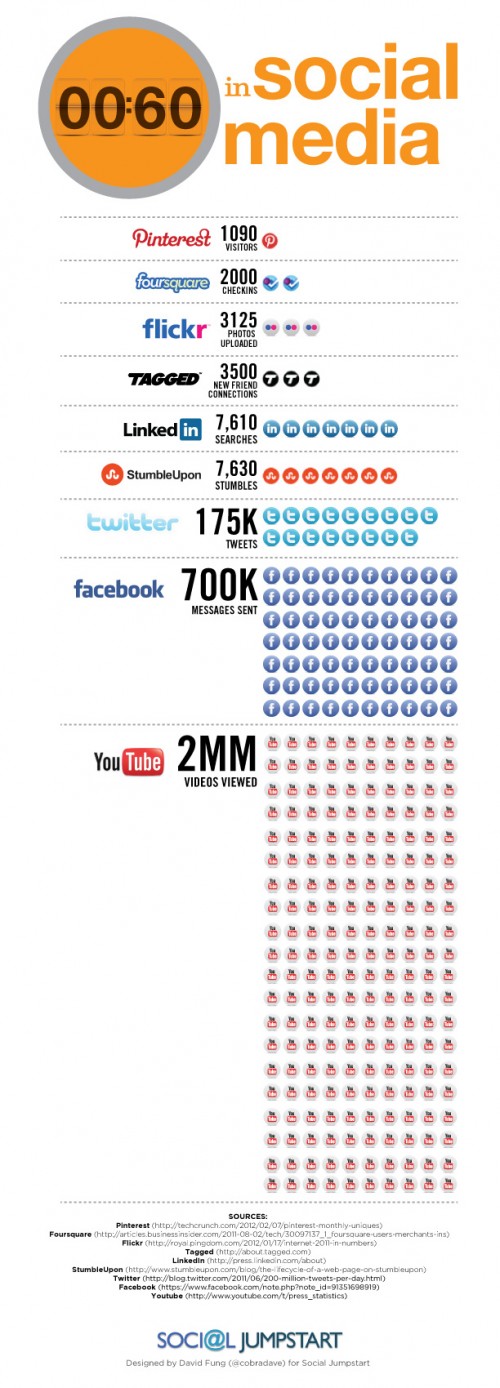We Are Social Asia Tuesday TuneUp #17
How Sina Weibo is faring against Twitter worldwide
There’s no doubt that Sina Weibo is big in China – it receives 1 in every 100 Internet visits in China. How then does it fare against Twitter, which is used internationally? Resonance China charted the percentage of visits both microblogging services received in the respective countries they’re used in for December 2011, and Sina Weibo sees a higher penetration in China than Twitter in the many countries it is available in, such as US, UK, India and Brazil. Interestingly enough, Twitter sees a higher percentage of visits in Singapore, where it is receiving 0.85% of Internet visits, compared to US, which sees only 0.23%, and UK, which accounts for 0.44%. This could be due to users accessing Twitter via third-party applications such as Hootsuite and Tweetdeck, or perhaps through Twitter’s mobile apps.
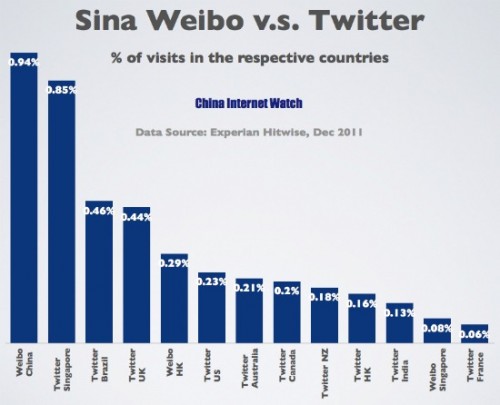
Sina Weibo promotes social good through its charity platform
Sina Weibo has included a charity platform ‘Gong Yi‘ to its microblogging site that will allow users to ‘follow’ and donate to good causes on the site itself. The concept seems slightly similar to Facebook Causes, a social fundraising tool available to non-profits that wish to integrate donation capabilities with their online efforts. The Gong Yi homepage categorises charities into education, child assistance, medical care, animal protection, and environmental protection, and on each charity’s page is displayed a progress meter that shows how far along it is to hitting its target amount of donations, as well as a donation button. Once Gong Yi is out of its beta phase, it’ll be interesting to see whether non-profits utilise the platform given the 250 million users on Sina Weibo.
Navigating the weibo waters in China
There are plenty of figures on the number of users Sina Weibo has, but the great takeaway from this infographic by Digital Jungle is the demographic data of Sina Weibo users. Apparently, females dominate Sina Weibo – 70.2% of Sina Weibo users are female, and the other 29.8% male. The majority of users, 68% of users to be precise, are aged 18 to 25, while 32% of users spend more than 3 hours on Sina Weibo per day.
‘Occupy Obama’
For months, Google+ had been banned in China. When the firewall was mysteriously removed last week, thousands of Chinese web users flocked to President Obama’s Google+ Page, in a move dubbed Occupy Obama. Yes they can.
LiveJournal Singapore launches LJ checkouts
LiveJournal Singapore will be launching e-commerce features through its brand new LJ Checkout platform, catering specifically to the unique local ecosystem of ‘blogshops’, which are online shopping websites hosted on the LiveJournal platform itself. The suite of new features include product catalogue creation, a shopping cart system, and an online payment gateway which will see it partnering with MOLPay. Given that the 50,000 or so blogshops in Singapore generated US$72 million or S$90.25 million in 2011, it’s no wonder LiveJournal Singapore is responding to this particular niche.
What happens on social media in 60 seconds
If you’ve ever thought that you can’t accomplish much in a single minute, think again. This infographic by Social Jumpstart shows you what happens on social media in a mere 60 seconds, and some of the figures are breathtaking indeed. 2 million videos are viewed on YouTube, 700,000 messages sent on Facebook, 25,000 stumbles on StumbleUpon (updated figures provided by a StumbleUpon representative), 7,610 searches on LinkedIn – all in the space of a minute.
Facebook announces partnership with mobile carriers to offer carrier billing
Today at Mobile World Congress, Facebook announced what could be a potentially game-changing move: it’s created an ecosystem where people can pay for things on their mobile phone bill directly through Facebook, in just three steps.
Facebook set to launch new premium ads and speed up Insights
According to a document leaked to Gigaom, Facebook plans to update its premium ads product by requiring their premium homepage ads to be in page post format.
According to Facebook, page posts significantly outperform other types of ads with 80% more chance of being remembered, a 40% increase in engagement, and a 16% increase in fan rate. These changes are expected to go into effect on Wednesday.
Facebook is also giving Insights, its analytics tool, a revamp. It is expected that they will soon show Page performance data in real-time or near real-time rather than on a 48 hour delay. This is an opportunity to give businesses the understanding necessary to drive higher ROI, which will in turn attract more brands and advertisers to the platform. According to Chad Wittman, EdgeRank Checker’s founder, making real-time Insights data available through the API “will give Page owners an opportunity to see how their Page actually lives and breathes”.
Twitter’s global takeover
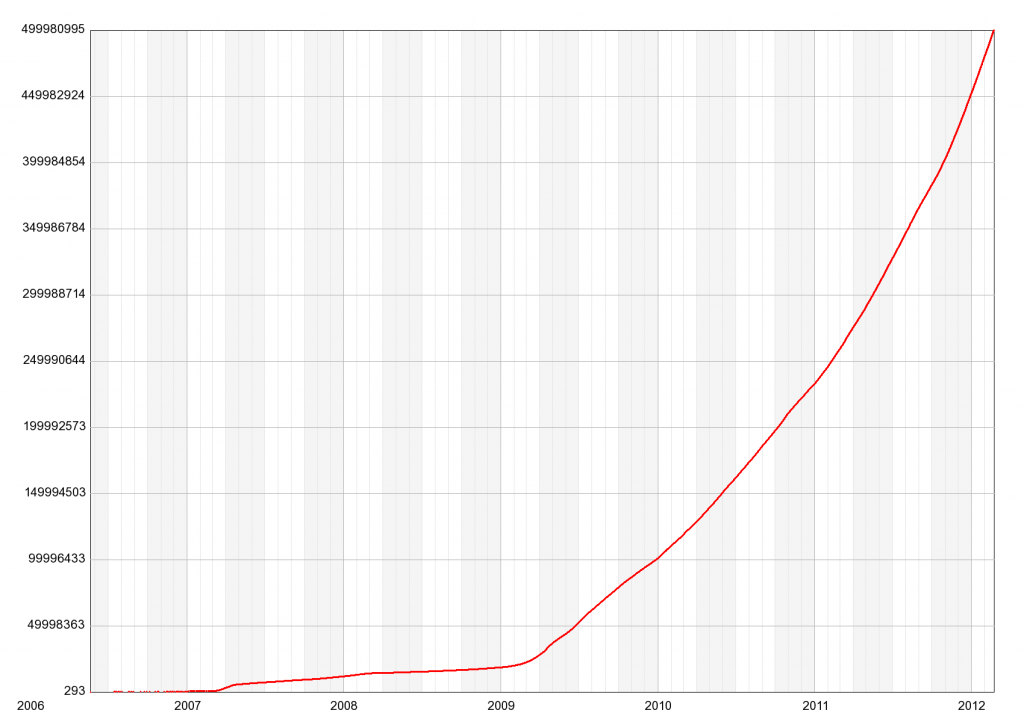
Twitter now has over 500 million users just ahead of its sixth birthday. This phenomenal global growth appears to have no plans to cease, with Twopcharts predicting it will hit 600 millions users in around 108 days. On top of this, Twitter has taken yet another step in its international growth by announcing that Google’s Russian rival, Yandex, is their new real-time search partner. Yandex says it has licensed the “full feed of all public tweets” covering all languages. This is an extremely clever move for Twitter in both extending its coverage and utility beyond its home market and English.
LinkedIn launch ‘Follow Company’ button
As of today, LinkedIn have launched an embeddable ‘Follow Company’ button, which companies can add to their sites, to allow anyone to follow their company on LinkedIn. Big news for those who like to stay connected.
Google+ integrates with Google Voice, adds ‘More By’ to search results
Google have announced that Google+ will now be linked to Google Voice by bringing information from your Google+ circles into your Google Voice phone account to make it even easier for you to organise your contacts. This means it will be easier than ever to manage your callers – i.e. ‘Creepers’ go straight to voicemail. It’s another step towards Google bringing Google+ to every Google web app, indicating that Google+ is now the “new mode of usage of Google” that its leaders envisioned – at least from Google’s perspective.
Google have also recently added a new ‘More By’ link to the authorship tag in search results which when clicked, brings up a personalised search results page containing all content by the author. At the top this features information about the author from Google+ and then below lists all the blog content. This is expected to soon be populated by more social content.

Pinterest hype not backed up by the numbers
Looking at the latest research from comScore, Pinterest actually lost users in the UK in January, despite only having 300,000 users to start off with. This might burst some people’s bubbles, but Pinterest is the ultimate embodiment of the Emperor’s New Clothes – just look at the graph! As for the rest of Europe, it’s barely even registering.
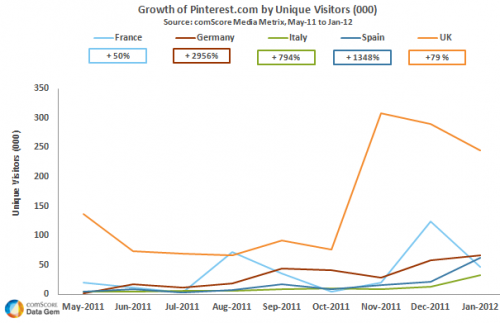
PeerIndex launch reward scheme
PeerIndex – a competitor to Klout – has launched a reward scheme, called PeerPerks, which offers free products and discounts, to those they consider influential. Visitors to PeerPerks.com can choose the offer they’re interested in and then find out if they have the Klout clout to be eligible for it.
NBA All-Star game adds social media offering
Yesterday’s NBA All-Star game saw two separate social activations. First, the annual Slam Dunk contest was opened up to Twitter, with users able to vote for their favourite player – by using their surname and the hashtag #SpriteSlam.
Second, and perhaps more interestingly, they teamed up with Shaker, a virtual nightclub which lives within Facebook. This allowed them to create a site which gave fans a chance to interact, chat, watch exclusive interviews and highlights, and test each other’s NBA knowledge. The by-product of all this is that is has been dubbed the most social NBA All-Star game, ever.
Could ‘Fringe’ be saved by a hashtag?
US TV-show Fringe was threatened with cancelation – because its audience was too, um, fringe. But a clever social media campaign has reached a lot of people, suggesting that it might be saved. It’s worth reading the full story to learn about the viewers’ strategy to save the programe, and how they’ve managed to reach such a huge online audience with their campaign.
Ford crowd-source ideas for mobile innovation
Around this week’s Mobile World Congress in Barcelona, Ford are looking to crowd-source answers to this question: What will communications technology in vehicles help us do in the future? The most interesting responses will be collated into a “customer vision” for mobile-vehicle interactions, and published via social media storytelling tool Storify. Users will need to focus in order to give Ford the fiesta of ideas they’re looking for.
Eurostar launch new social platform, Eurostar Live
Last week saw Eurostar launch their new social platform, Eurostar Live, with a little help from the We Are Social team in London. It brings social media commentary by the general public about Eurostar’s destinations to 363 public display screens across London and the South East.

Kellogg’s develop Totes Amazeballs cereal after Twitter suggestion
Kellogg’s developed a cereal for The Charlatans front man Tim Burgess after he announced his interest in developing a cereal to his followers on Twitter. They created Totes Amazeballs, after Burgess tweeted that he wanted to create a new super cereal which would be Rocky Road flavoured, using the hashtag #totesamazeballs.
Having seen the tweets, Kellogg’s decided to commission the idea in the singer’s honour, with the cereal ultimately containing Kellogg’s Coco Pops Rocks, marshmallows, shortbread pieces and raisins. It remains to be seen whether this was a one-off, or whether Kellogg’s will make this a serial feat.
Absolut London Instagram competition
As part of the launch of their newly-designed bottles, Absolut London are running an Instagram competition to win one of the limited edition bottles.

People like big chocolate bars
Last week Mars announced it was cutting back the size of a whole range of its products, in order to ensure none were more than 250 calories. Judging by the comments on the Snickers Facebook Page, people like big chocolate bars. Picnic.
